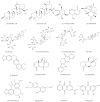Herbal medicines and nonalcoholic fatty liver disease
- PMID: 27570425
- PMCID: PMC4974587
- DOI: 10.3748/wjg.v22.i30.6890
Herbal medicines and nonalcoholic fatty liver disease
Abstract
Nonalcoholic fatty liver disease (NAFLD), which is characterized by excessive fat accumulation in the liver of patients who consume little or no alcohol, becomes increasingly common with rapid economic development. Long-term excess fat accumulation leads to NAFLD and represents a global health problem with no effective therapeutic approach. NAFLD is considered to be a series of complex, multifaceted pathological processes involving oxidative stress, inflammation, apoptosis, and metabolism. Over the past decades, herbal medicines have garnered growing attention as potential therapeutic agents to prevent and treat NAFLD, due to their high efficacy and low risk of side effects. In this review, we evaluate the use of herbal medicines (including traditional Chinese herbal formulas, crude extracts from medicinal plants, and pure natural products) to treat NAFLD. These herbal medicines are natural resources that can inform innovative drug research and the development of treatments for NAFLD in the future.
Keywords: Herbal medicines; Natural product; Nonalcoholic fatty liver disease; Review; Traditional Chinese medicines.
Figures




References
-
- Schuppan D, Gorrell MD, Klein T, Mark M, Afdhal NH. The challenge of developing novel pharmacological therapies for non-alcoholic steatohepatitis. Liver Int. 2010;30:795–808. - PubMed
-
- Byrne CD, Targher G. NAFLD: a multisystem disease. J Hepatol. 2015;62:S47–S64. - PubMed
-
- Bhatia LS, Curzen NP, Calder PC, Byrne CD. Non-alcoholic fatty liver disease: a new and important cardiovascular risk factor? Eur Heart J. 2012;33:1190–1200. - PubMed
-
- Fan JG, Farrell GC. Epidemiology of non-alcoholic fatty liver disease in China. J Hepatol. 2009;50:204–210. - PubMed
Publication types
MeSH terms
Substances
LinkOut - more resources
Full Text Sources
Other Literature Sources
Medical
Miscellaneous

